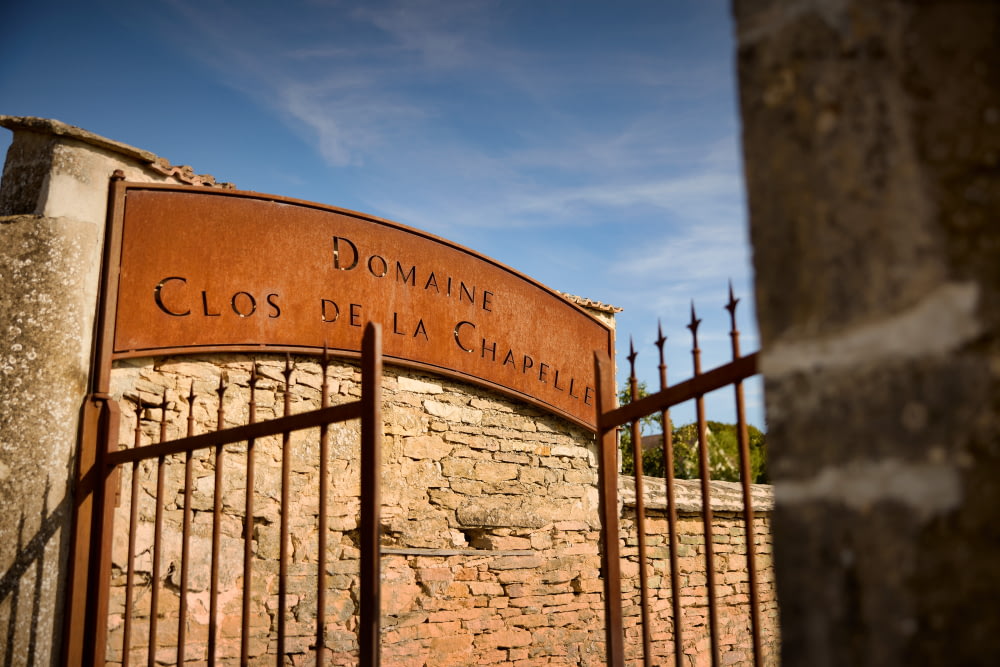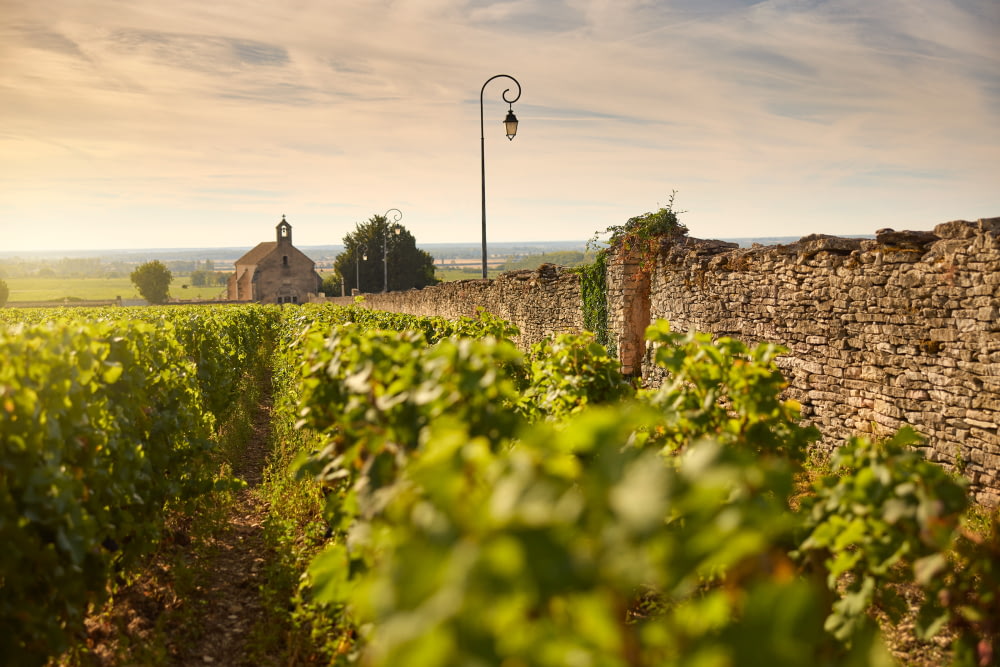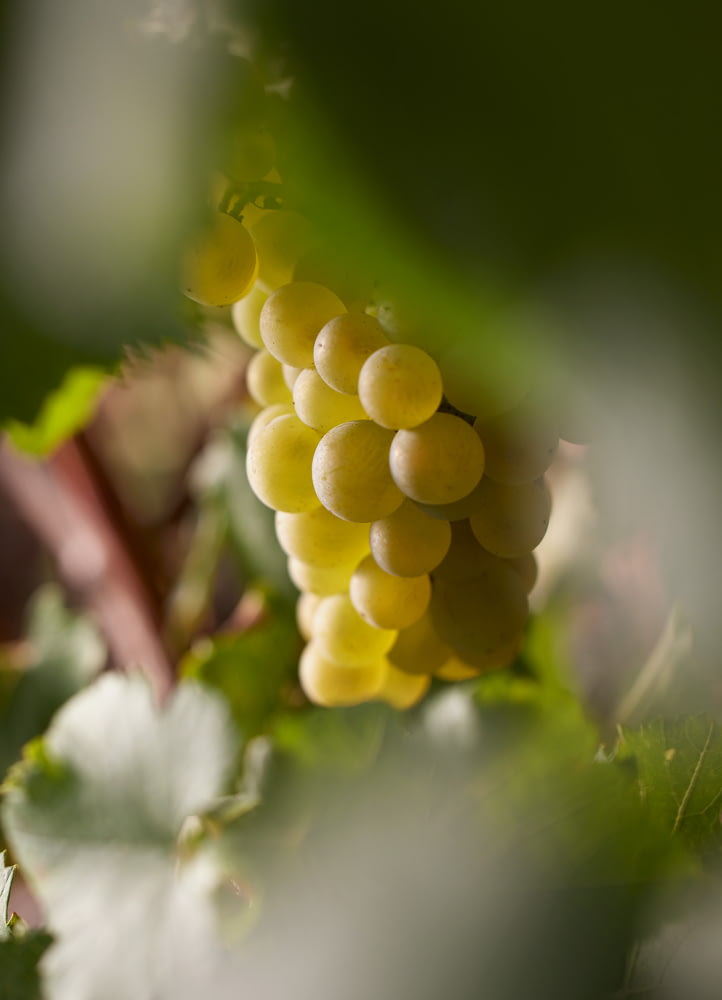Presentation
We were able to purchase
this historic property in 2011
& rechristened it in honor of its flagship monopole
as the Domaine Clos de la Chapelle.
The exquisite monopole vineyard, Clos de la Chapelle, has a long and colorful history, intertwined with the story of the beautiful chapel, for which it is named, and the historic village of Volnay, once home of the Dukes of Burgundy. The chapel vineyard is located directly across the lane from the chapel, and beneath the walls of the former château of the Dukes of Burgundy.
Clos de la Chapelle is under the auspices of the Notre Dame de Pitié, to whom it was dedicated in 1540, when this spacious, Gothic chapel was constructed. The winegrowers' prayers at the Notre Dame de Pitié are famous for having saved the population from cholera, which ravaged the region in 1840. In 1870 and 1871, the Prussians turned away from the village, perhaps in deference to the chapel and the powers of Notre Dame de Pitié. The chapel, and adjacent cemetery, is a beautiful and historically significant landmark in the Volnaysian region.
The Dukes of Burgundy constructed a chateau in Volnay in the 8th century, and successive generations of dukes visited or resided in Volnay intermittently through the centuries. Robert II (1248-1306), Duke of Burgundy, received tribute from his barons at the chateau in 1272. His wife, Agnes, daughter of Saint Louis, lived there as well. The succession of the Duchess of Burgundy to the throne in 1315 was celebrated in Volnay and was ordained by Eudes IV, who would later restore the château's chapel. Today, the mayor and the municipal offices of Volnay occupy the former chateau.

Clos de la Chapelle was part of the ensemble of parcels that previously constituted the Bousse d'Or.
This Clos would not take the name of Clos de la Chapelle until 1937 because during the setting up of appellations, the administration of INAO (National Institute of the Origin and the Quality) mentioned the vineyard under the village denomination, Clos des Ducs.

This land parcel was particular in that it was side-by-side with the Bousse d'Or. Surrounded by walls, it faced the entrance of the chapel. This vineyard was thus a seigniorial land and was included in the Bousse d'Or until 1865.
The colorful and meticulously researched book, Volnay Clos de la Chapelle: The History of a Vineyard, by Philippe Remoissenet (c 2012) traces the history (beginning in 1425) of the two parcels that were eventually combined to become the monopole we know today. "To summarize, the Clos de la Chapelle was originally part of the Bousse d'Or. One parcel was property of the Brotherhood of the Saint Sacrément and a second parcel belonged to the Carmelite Nuns of Beaune. The revolution and the buyback of ecclesiastical land as national assets resulted in changing ownership. The Pinard family acquired the two entities that would later be reunited by Victor Boillot."

During the domaine's early era, Louis Pasteur requested as many as 50 bottles of wine from Victor Boillot as samples to use in his research and testing of wine diseases. The Emperor (Napoleon III) recognized Pasteur's research as "being capable of saving millions of francs for France."
Pasteur's letters to Victor Boillot over several decades give details concerning the alteration of the non-heated wines and arrived at the conclusion that "one heating was enough to protect the wines from germs and keep them during transportation."
The final Domaine Louis Boillot was comprised of three small premier Cru vineyards: Pommard Les Chanlins (très vieilles vignes), Volnay Carelle sous la Chapelle (now known as Volnay En Carelle), and the monopole Volnay Clos de la Chapelle.
With the addition of 13 additional appellations, all premier cru and Grand Cru, we now have 16 distinct terroirs at Domaine Clos de la Chapelle, with a total of 5 hectares in planted vineyards.

My business colleagues, Philippe Remoissent and Pierre Meurgey, had their eyes on the picturesque monopole vineyard which is Clos de la Chapelle for many years - from long before we met early in the 21st century.
I am very fortunate and grateful to have had the opportunity to purchase the clos with them and to rename Domaine Louis Boillot as Domaine Clos de la Chapelle.




In addition to the Clos, the Domaine now owns and farms portions of a number of small vineyards :
Volnay 1er cru Clos de la Chapelle (monopole)
Volnay 1er cru En Carelle
Volnay 1er cru Taillepieds (vieilles vignes)
Volnay 1er cru Santenots du Milieu
Pommard 1er cru Les Chanlins (très vieilles vignes)
Pommard 1er cru Grands Epenots
Pommard Rue au Port (vignes centenaires)
Beaune 1er cru Champs Pimont
Beaune 1er cru Les Teurons
Beaune 1er cru Les Reversées (blanc)
Pernand Vergelesses 1er cru Sous Frétille
Corton Charlemagne
Corton Bressandes
Meursault Vignes Blanches
Meursault Cuvée Confluence
Meursault 1er cru Charmes

Together with Coralie Allexant-Manière, our technical director, and Frédéric Gaillard, our vineyard manager, we share the vision of organic viticulture and biodynamic practices with the goal of producing the best expression of terroir inherent in each tiny parcel.
Our total production for all vineyards combined is about 1800 cases in an average year.
My passion for this project and commitment to the highest quality wines is unending.
When one intertwines the rhythm of the vintages spawned from a particular terroir with the concurrent turbulent cycles of society, a fascinating temporal tapestry of Western Culture emerges.
Who would not leap at the chance to be a small part of such tradition?
We hope you enjoy learning about the history of this special place and thank you in advance for appreciating our rare, terroir-driven wines.
Mark M. O'Connell
Propriétaire - Récoltant


With our goal to obtain the purest wines possible, the transformation of all of the DCC properties to organic and biodynamic vineyards began immediately following our purchase of the domaine. As with all great Burgundies, our grapes are hand-harvested, and there is minimal intervention with the wine during vinification.
Domaine Clos de la Chapelle vineyards are certified organic and we follow biodynamic principles.
For the red wines, up to 25% whole cluster is used during vinification and the amount varies based on the healthiness of the stems and the characteristics of the vintage.

Viticulture
Domaine Clos de la Chapelle vineyards are certified organic and we follow biodynamic principles.
Among other guidelines, this means:
· Soil is ploughed 3 times per year;
· Spraying occurs only with contact products; no chemical pesticides or fertilizers are used;
· De-budding occurs to control yield, limiting to 4 shoots for a maximum yield of 35hl/ha;
· 500 P - cow-horn manure for biodynamic treatment is applied in the beginning of winter and in mid-May; and
· Copper treatments of 700g are applied; (4kg/year maximum allowed to retain biodynamic status).
· We practice a single Guyot pruning, and are working towards lowering the vine height.

Vinification
For the red wines, up to 25% whole cluster is used during vinification and the amount varies based on the healthiness of the stems and the characteristics of the vintage.
In addition we adhere to the following protocols:
· Sorting table
· Cold-maceration for 6 to 7 days
· Indigenous yeast
· Pumpovers twice a day until towards the end of fermentation when we emply one punch down and one pumpover each day
· Temperatures brought up gradually to 30 degrees Celsius.
· Three week maceration
· 24 to 48 hour settling
· Up to 30% new oak with medium toast Allier barrels
· Only 1 racking
· No fining or filtering
· bottling 15 – 18 months after harvest
For the white wines, our protocol is as follows:
· Sorting table if disease is present
· Whole cluster pressing
· 24 hour settling after pressing
· Up to 30% new oak, with a combination of Radoux, Remond and Damy barrels
· Batonnage once a week for up to 6 weeks after fermentation or until malo starts
· Bottling 15 – 18 months after harvest

Spraying occurs only with contact products; no chemical pesticides or fertilizers are used;
De-budding occurs to control yield, limiting to 4 shoots for a maximum yield of 35hl/ha;
500 P - cow-horn manure for biodynamic treatment is applied in the beginning of winter and in mid-May; and
Copper treatments of 700g are applied; (6kg/year maximum allowed to retain biodynamic status).
We practice a single Guyot pruning, and are working towards lowering the vine height.





